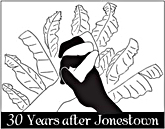 Most accounts of Peoples Temple end in Jonestown on 18 November 1978. This is as true today as it was thirty years ago. Books, documentaries, articles, and television programs tend to focus on Jim Jones and conclude with the deaths of more than 900 men, women, and children in Guyana.
Most accounts of Peoples Temple end in Jonestown on 18 November 1978. This is as true today as it was thirty years ago. Books, documentaries, articles, and television programs tend to focus on Jim Jones and conclude with the deaths of more than 900 men, women, and children in Guyana.
But for the people who belonged to Peoples Temple, the story of being a survivor began that day. About eighty Jonestown residents survived, most by being in Georgetown, but others by fleeing from Jonestown. About 150 Temple members were living in San Francisco, 80 in Los Angeles, and 20 in Redwood Valley. In addition to these survivors, hundreds of former members also lost family members that day. And the lives of thousands of relatives were forever changed.
For this special 30th Anniversary issue of the jonestown report, we asked survivors to reflect upon their lives since Jonestown. Neither scholars nor the news media have examined this aspect of the Peoples Temple story. It is an important story, however, in several respects. First, Peoples Temple is larger than Jonestown, its defining moment. Indeed, the narratives of survivors challenge the very notion that “Jonestown” is all there is to know about Peoples Temple. Second, their reflections offer insights into life inside the Temple in its heyday. Finally, their accounts testify to the resilience of the human spirit, and may give hope to other survivors who are still wrestling with grief, shame, and depression.
What differentiates Jonestown survivors from those who have prevailed over other tragedies—such as families of those who died in the World Trade Center in 2001, or the relatives of airplane crash victims—is that theirs is a grief denied. Society shunned them and called them “baby-killers”; it called the dead “cultists” and “fanatics” and worse. The reaction they received was condemnation, not condolence; sarcasm, not sympathy. As their narratives show, being part of Peoples Temple meant being silenced as a survivor.
That is why their stories are so valuable. Survivors are breaking the silence at this juncture to share with others—insiders and outsiders alike—the hard-won lessons of their losses. It is all the more extraordinary, then, when one survivor concludes, “This is a very good life.” This is not the cheap grace of store-bought religion, but instead is the perspective of the survivors who have been able to transform the pain of their profound and life-long grief into compassion for the anguish of others.
We are grateful for their courage, their honesty, and their willingness to share their lives with us on this anniversary, undoubtedly the last to receive much public consideration. The experiences survivors have had with the media have not been encouraging, as they reveal, so we are honored to present these survivor tales. We hope they encourage others to write as well.
“Joy and woe are woven fine/a clothing for the soul divine,” wrote William Blake in “Auguries of Innocence.”
Under every grief and pine/runs a joy with silken twine.
It is right it should be so/Man was made for joy and woe.
And once this we rightly know/Through the world we safely go.
I have reversed the order of Blake’s verses so that we end going safely through the world, even though we know that the world is a sad and tragic and dangerous place. No one knows that better than Peoples Temple survivors. At the same time, over the last three decades they also have been able to find joy—in family, in art, in friends, in pets, in work, and in the community of loss they share with thousands of people whose relatives died in Jonestown.
–– Rebecca Moore
(Rebecca Moore is a professor of Religious Studies at San Diego State University. She has written and published extensively on Peoples Temple and Jonestown (listed here), including Understanding Jonestown and Peoples Temple (Praeger, 2009), an extensive description on the Temple appears at the World Religions & Spirituality Project at Virginia Commonwealth University, and numerous articles on this website, of which she is the co-manager.